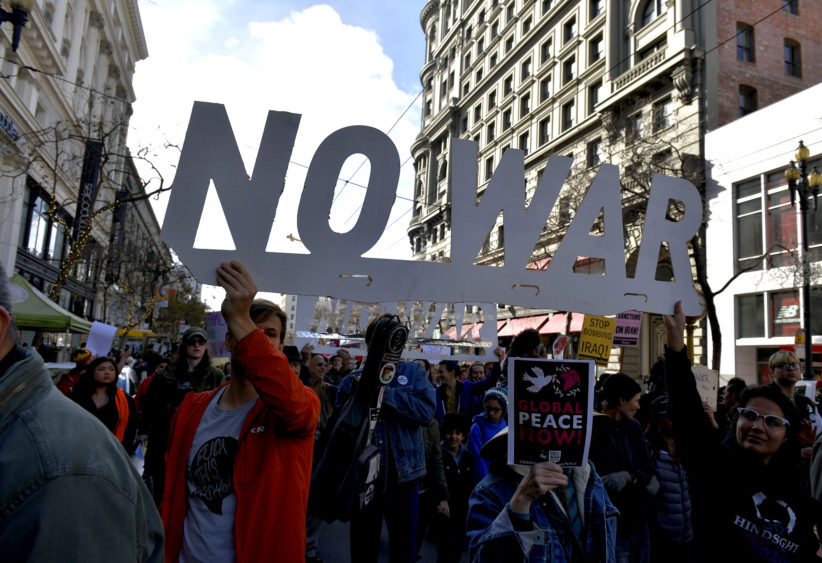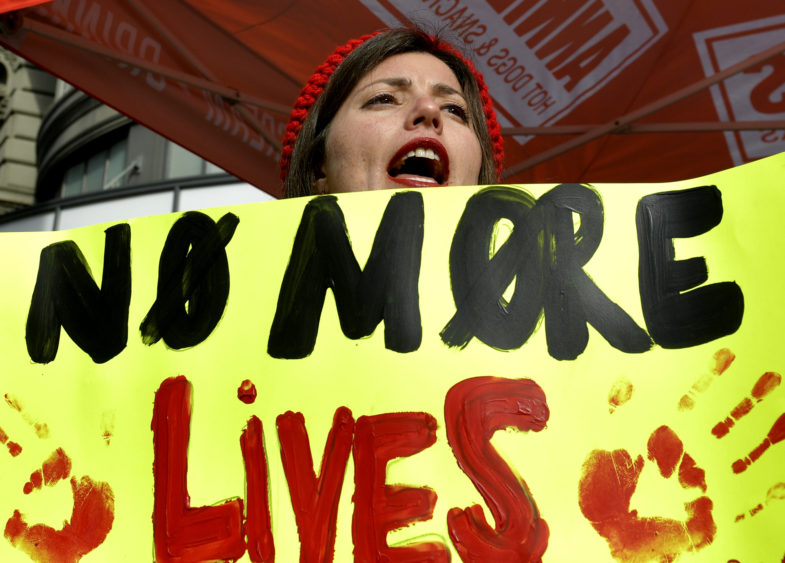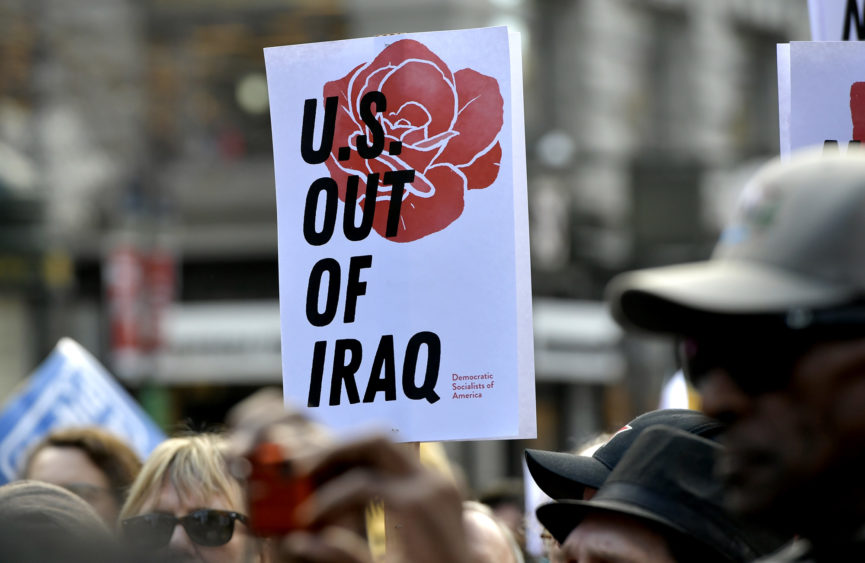The first days of the new year came crashing down with renewed fears of yet another war in the Middle East.
On Dec. 31, as the U.S. Embassy in Baghdad was under a one-day siege by Iranian-backed militia, President Donald Trump responded to reporters about whether he foresaw war with Iran. From his Mar-a-Lago New Year’s Eve party, he said:
“No. I want to have peace. I like peace. And Iran should want peace more than anybody. So I don’t see that happening.”
Tweet this!
Trump’s actions and rhetoric since suggest otherwise.
According to BBC reporting, the U.S. launched a drone strike on a Baghdad International Airport in Iraq two days after militia forces withdrew from the embassy. The strike killed top Iran military general Qasem Soleimani and several others, including Abu Mahdi al-Muhandis.
Soleimani was notoriously credited with the use of deadly explosively formed penetrators against U.S. military armored vehicles and soldiers, as reported by U.S. Department of Defense-authorized Stars and Stripes. Muhandis was considered a designated terrorist for his role in the 1983 Kuwait bombings.

Protests in the U.S. erupted over the weekend. Thousands turned out to Market Street Saturday with signs, old and new, and a raging call to stop a potential war with Iran before it starts.
About 80 groups gathered in different cities nationwide and echoed that call. Hordes marched city streets in Chicago, Boston and Los Angeles.
Of all the signs and speeches over the weekend, one theme repeatedly emerged: No war with Iran.
Despite calls to deescalate the situation before it gets much worse, Trump has ratcheted the rhetoric. In an odd tweet Sunday, the president said:
“These Media Posts will serve as notification to the United States Congress that should Iran strike any U.S. person or target, the United States will quickly & fully strike back, & perhaps in a disproportionate manner. Such legal notice is not required, but is given nevertheless!”
Tweet this!
It’s no secret that there’s no love lost between American forces and Soleimani, but very little information has been released as to why the Trump administration chose to strike when and where it did. U.S. Secretary of State Mike Pompeo made rounds on the cable news circuit Sunday morning with a vague assertion that killing Soleimani was necessary to disrupt an “imminent attack,” though he did not elaborate or offer concrete details.
The legality of the strike without Congressional consultation or approval is under heavy scrutiny. House Speaker Nancy Pelosi (D-Calif) responded Monday with an announcement that the House plans to hold a vote this week on a war powers resolution. Pelosi said:
“(The resolution) reasserts Congress’s long-established oversight responsibilities by mandating that if no further Congressional action is taken, the Administration’s military hostilities with regard to Iran cease within 30 days.”
Tweet this!
Mark DeSaulnier, who represents Contra Costa County in California’s District 11, commented Monday via Twitter:
“The Constitution grants Congress the power to declare war. It also charges Congress with the responsibility of providing oversight. (House democrats) are committed to upholding the Constitution and keeping Americans safe.”
Tweet this!

International tension is thick this week as Iran has vowed to take serious revenge against the U.S., and members of Iraqi parliament have voted on a non-binding resolution to expel U.S. troops from the country, where they’ve been stationed in a collaborative effort to combat ISIS.
An impeachment-embroiled Trump has threatened, on Twitter, that if Iran attacks in any way, the U.S. is prepared to bomb 52 Iranian locations, including cultural sites. Destruction of cultural heritage sites is considered a war crime by the United Nations Security Council. The number 52 is symbolic of the number of American hostages taken during the 1979 revolution and attack on the U.S. Embassy in Tehran.
Putting it mildly, the relationship between Iran and the U.S. has been one of constant turmoil for the past four decades, but tensions have increased significantly under Trump’s leadership.
In May 2018, Trump announced the U.S. would withdraw from the nuclear deal crafted by former Secretary of State John Kerry in collaboration with the UK, France, China, Russia and Germany. The agreement, which Trump called “defective,” and campaigned to overturn as a presidential candidate in 2016, had restricted Iran’s uranium enrichment activity while lifting sanctions against the country’s business sector.
For a time, the agreement had alleviated concern among allies in the area of Iran’s nuclear proliferation. And despite American withdrawal, Iran had agreed, until this week, to continue working with the remaining countries.
But as of Sunday, Iran announced that their nuclear program will no longer be bound by any limitations set forth in the 2015 deal.
The timeline since May 2018 has been wrought with back-and-forth aggression in the form of military attacks and killings on Iraqi and Syrian soil. Iran shot down a U.S. drone and allegedly killed a U.S. contractor. The U.S. killed 25 fighters in “defensive strikes.” The number of U.S. troops deployed to the region has steadily risen with each Iranian retaliation, including up to 4,200 members of the 82nd Airborne Division sent this week as an immediate response force.

The increased military presence in Iraq pushed the situation to a boiling point at the embassy in Baghdad. No fatalities or serious injuries were reported as a result of the incident.
However, it is still unknown exactly what “imminent” threat warranted the assassination of high-powered Iranian leaders on Iraqi soil.
According to Pompeo’s cable appearances, the Trump administration claims America is safer after Thursday’s attack and the killing of Soleimani. But not all are convinced.
Iran was until recently experiencing an intense level of unrest among its citizens who were angered by increased oppression and rising oil prices. However, Soleimani’s death reunified the masses in objection to U.S. forces, essentially squashing an uprising that could have resulted in a forced regime change.
Some factions in Iraq have expressed similar anger in response to the attack. “Death to America” chants have boomed from Iranian streets and from the halls of Iraqi parliament in the past few days.
Collective anger in the Middle East is a rising concern for the safety of U.S. troops. An unchecked Iranian nuclear program is a source of fear for citizens across the Middle East, Europe, and in the States.
